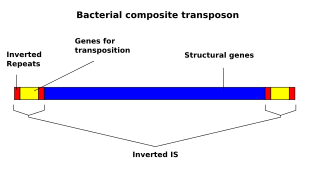
Back جين قافز Arabic Транспозон Bulgarian Transpozon BS Transposó Catalan Transpozon Czech Transposon Danish Transposon German Transposón Spanish Transponeeruvad elemendid Estonian Transposoi Basque

A transposable element (TE, transposon, or jumping gene) is a nucleic acid sequence in DNA that can change its position within a genome, sometimes creating or reversing mutations and altering the cell's genetic identity and genome size.[1] Transposition often results in duplication of the same genetic material. In the human genome, L1 and Alu elements are two examples.[2] Barbara McClintock's discovery of them earned her a Nobel Prize in 1983.[3] Its importance in personalized medicine is becoming increasingly relevant, as well as gaining more attention in data analytics given the difficulty of analysis in very high dimensional spaces.[4][further explanation needed]
Transposable elements make up a large fraction of the genome and are responsible for much of the mass of DNA in a eukaryotic cell. Although TEs are selfish genetic elements, many are important in genome function and evolution.[5] Transposons are also very useful to researchers as a means to alter DNA inside a living organism.
There are at least two classes of TEs: Class I TEs or retrotransposons generally function via reverse transcription, while Class II TEs or DNA transposons encode the protein transposase, which they require for insertion and excision, and some of these TEs also encode other proteins.[6]
- ^ Bourque G, Burns KH, Gehring M, Gorbunova V, Seluanov A, Hammell M, et al. (November 2018). "Ten things you should know about transposable elements". Genome Biology. 19 (1): 199. doi:10.1186/s13059-018-1577-z. PMC 6240941. PMID 30454069.
- ^ Altemose, Nicolas; Logsdon, Glennis A.; Bzikadze, Andrey V.; Sidhwani, Pragya; Langley, Sasha A.; Caldas, Gina V.; Hoyt, Savannah J.; Uralsky, Lev; Ryabov, Fedor D.; Shew, Colin J.; Sauria, Michael E. G.; Borchers, Matthew; Gershman, Ariel; Mikheenko, Alla; Shepelev, Valery A. (April 2022). "Complete genomic and epigenetic maps of human centromeres". Science. 376 (6588): eabl4178. doi:10.1126/science.abl4178. ISSN 0036-8075. PMC 9233505. PMID 35357911.
- ^ McClintock B (June 1950). "The origin and behavior of mutable loci in maize". Proceedings of the National Academy of Sciences of the United States of America. 36 (6): 344–55. Bibcode:1950PNAS...36..344M. doi:10.1073/pnas.36.6.344. PMC 1063197. PMID 15430309.
- ^ Wellinger, RE, et al. (2022). "A new challenge for data analytics: transposons". BioData Mining. 15 (9): 9. doi:10.1186/s13040-022-00294-x. PMC 8957154. PMID 35337342.
- ^ Bucher E, Reinders J, Mirouze M (November 2012). "Epigenetic control of transposon transcription and mobility in Arabidopsis". Current Opinion in Plant Biology. 15 (5): 503–10. doi:10.1016/j.pbi.2012.08.006. PMID 22940592.
- ^ Pray LA (2008). "Transposons: The jumping genes". Nature Education. 1 (1): 204.